-
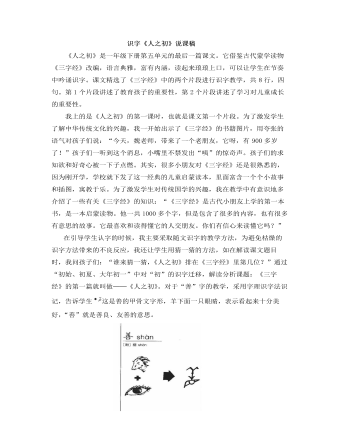
部编人教版一年级下册识字 《人之初》说课稿
我上的是《人之初》的第一课时,也就是课文第一个片段。为了激发学生了解中华传统文化的兴趣,我一开始出示了《三字经》的书籍图片,用夸张的语气对孩子们说:“今天,魏老师,带来了一个老朋友,它呀,有900多岁了!”孩子们一听到这个消息,小嘴里不禁发出“咦”的惊奇声。孩子们的求知欲和好奇心被一下子点燃。其实,很多小朋友对《三字经》还是很熟悉的,因为刚开学,学校就下发了这一经典的儿童启蒙读本,里面富含一个个小故事和插图,寓教于乐。为了激发学生对传统国学的兴趣,我在教学中有意识地多介绍了一些有关《三字经》的知识:“《三字经》是古代小朋友上学的第一本书,是一本启蒙读物。他一共1000多个字,但是包含了很多的内容,也有很多有意思的故事。它最喜欢和读得懂它的人交朋友。你们有信心来读懂它吗?”
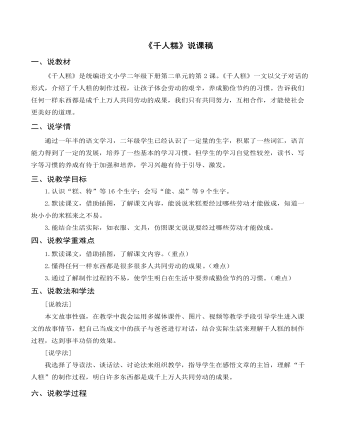
(说课稿)《千人糕》部编人教版二年级上册语文
四、说教学重难点1.默读课文,借助插图,了解课文内容。(重点)2.懂得任何一样东西都是很多很多人共同劳动的成果。(难点)3.通过了解制作过程的不易,使学生明白在生活中要养成勤俭节约的习惯。(难点)五、说教法和学法[说教法]本文故事性强,在教学中我会运用多媒体课件、图片、视频等教学手段引导学生进入课文的故事情节,把自己当成文中的孩子与爸爸进行对话,结合实际生活来理解千人糕的制作过程,达到事半功倍的效果。[说学法]我选择了导读法、谈话法、讨论法来组织教学,指导学生在感悟文章的主旨,理解“千人糕”的制作过程,明白许多东西都是成千上万人共同劳动的成果。

部编人教版四年级下册《乡下人家》说课稿(二)
(一)音画同步,创设情境感知文章结构,明确学习任务上课伊始,教师先出示乡下风光的多媒体课件,配乐旁白:这是顺着棚架爬上屋檐的碧绿藤蔓;这是依着时令次第开放的鲜花;这是茂密竹林中破土而出的春笋;这是觅食的鸡群戏水的小鸭。这里就是充满诗情画意的乡下人家。在作者的眼里乡下人家的画面是怎样的?学生借助第一课时感知的框架,加上画面的重现,在文字的引领下,下乡来了解这是什么样的“家”,是怎样的“人”。学生能在最短的时间内引发阅读期待,走进乡下人家。为深入感知理解课文内容,体会作者描写上独特的表达方式奠定了基础。(二)整合内容,教师导学细化理解方法,夯实学习实效教师引导学生整体感知后直奔中心:“独特、迷人”来统领全文教学,抓住文章第一自然段明确用“抓重点句、关键词”的方法品味风景“独特”在哪里,“迷人”在何处?这样激起了学生探究作者是怎样用文字生动形象地描述一幅幅画面的欲望。联系生活实际理解对比的描写方法并不难,抓住动词体会也很容易,但是透过文字提取情感,再联系落实到朗读感受就是需要教师具体操作,学生体验实践的最具实效的学习历程。

部编人教版五年级上册《猎人海力布》说课稿
一、教材分析《猎人海力布》是一则在内蒙古自治区流传的民间故事,故事描写了善良、诚实的海力布,为了拯救乡亲们的生命,不惜自己变成一块石头。人们因此世世代代纪念他。这则故事虽然篇幅较长,但语言通俗易懂,围绕海力布“舍己救乡亲”的中心事件,层层铺垫,寓理寓情于故事中,给人强烈的感染和教育。本单元的训练重点是简要复述课文。从教材本身看,本课有以下特点:一是课题表明写人;二是情节生动,语言通俗易懂;三是想象力奇特丰富。二、教学目标分析要学生简要复述课文,首先要让学生熟悉课文内容,理清课文脉络,因此第一个教学目标定位为熟悉课文,了解事件的起因、经过、结果。要学生复述好课文,可以借助列小标题的方法理解课文内容、理清层次、找出要点。除了熟悉课文内容外,还要理解把握理解课文内容及把握人物的品质,因此,第二个目标定位品读课文,感悟人物的形象、品质。第三目标定位简要复述故事,并初步学习将人物对话改成一般叙述的方法。
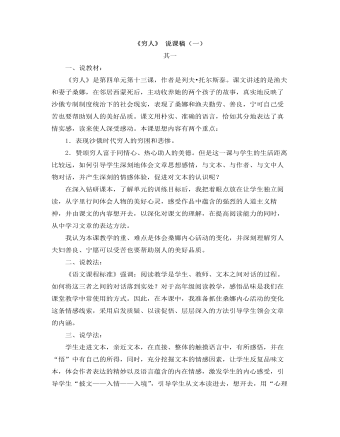
部编人教版六年级上册《穷人》说课稿(一)
四、说教学过程:我准备分两课时来完成本课的教学。现在着重说说第一课时,在这一课时里,主要引导学生初读课文,自学字词,了解课文的主要内容。通过学习,学生了解到文章讲的是渔夫和妻子桑娜(板书)在邻居西蒙死后,主动收养西蒙的两个孩子的事。抓住重点语句细读深思、用心感悟。在理解内容的基础上,把握文章的中心,体会穷人的美好心灵。体会他们的善良、乐于助人的美好品质。这样,学生就能由浅入深,由表及里地探究课文,使教路、学路、文路和谐统一,同步进行,从而培养学生多方面的语文能力,实现教师、学生、文本之间的对话。我设计了这样的结束语:“选择责任,选择实践良知,这是最重要的东西。选择爱,主动给别人爱,就会有意想不到的收获!”
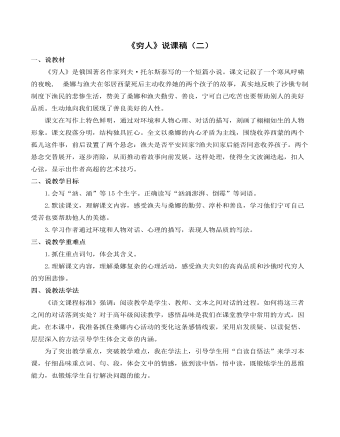
部编人教版六年级上册《穷人》说课稿(二)
三、说教学重难点1.抓住重点词句,体会其含义。2.理解课文内容,理解桑娜复杂的心理活动,感受渔夫夫妇的高尚品质和沙俄时代穷人的穷困悲惨。 四、说教法学法 《语文课程标准》强调:阅读教学是学生、教师、文本之间对话的过程。如何将这三者之间的对话落到实处?对于高年级阅读教学,感悟品味是我们在课堂教学中常用的方式。因此,在本课中,我准备抓住桑娜内心活动的变化这条感情线索,采用启发质疑、以读促悟、层层深入的方法引导学生体会文章的内涵。 为了突出教学重点,突破教学难点,我在学法上,引导学生用“自读自悟法”来学习本课,仔细品味重点词、句、段,体会文中的情感,做到读中悟,悟中读,既锻炼学生的思维能力,也锻炼学生自行解决问题的能力。
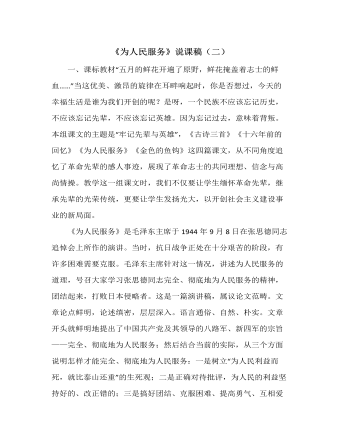
部编人教版六年级下册《为人民服务》说课稿(二)
二、教法学法(一)突出主体,选择教法:课堂是学习的场所,学生是学习的主人。《语文课程标准》明确指出:“积极倡导自主、合作、探究的学习方式”,要充分发挥学生的主体作用,全面提高学生的语文素养。基于以上的认识,我选择教法如下:1.以读为主,读思写结合法;2.引扶放相结合,意在引导学生注意议论文的特点与学习方法,从而培养学生自能读书的能力与习惯。(二)重在实践,指导学法:“语文是实践性很强的课程”,就是要让学生在大量的语文实践中掌握运用语文的规律与方法,也就是既要“授人以鱼”,更要“授人以渔。为此,我指导学生以读为本,体会文章论述方法、抓住重点词句进行理解课文。三、教学过程:(一)回忆旧知,导入新课1.上节课我们通过学习课文,你还记得课文中心论点是什么吗?哪个句子点明了这个观点?(指名答,板书:全心全意为人民服务)2.课文从哪些方面对这个观点展开叙述?(指名答,板书:死的意义、正确对待批评、团结人民)
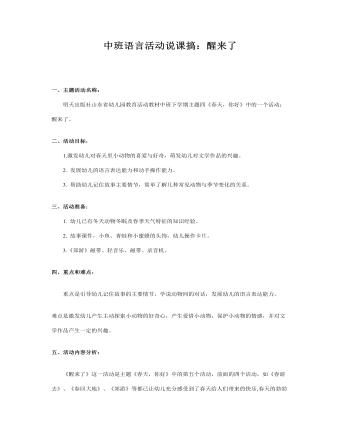
幼儿园中班语言活动说课搞:醒来了
二、活动目标:1.激发幼儿对春天里小动物的喜爱与好奇,萌发幼儿对文学作品的兴趣。2. 发展幼儿的语言表达能力和动手操作能力。3. 帮助幼儿记住故事主要情节,简单了解几种常见动物与季节变化的关系。三、活动准备:1. 幼儿已有冬天动物冬眠及春季天气特征的知识经验。2. 故事课件,小鱼、青蛙和小蜜蜂的头饰,幼儿操作卡片。3.《郊游》磁带、轻音乐、磁带、录音机。四、重点和难点: 重点是引导幼儿记住故事的主要情节,学说动物间的对话,发展幼儿的语言表达能力。难点是激发幼儿产生主动探索小动物的好奇心,产生爱惜小动物,保护小动物的情感,并对文学作品产生一定的兴趣。
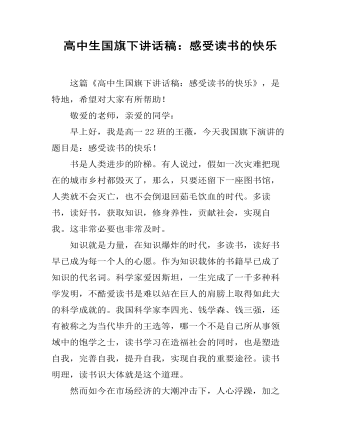
高中生国旗下讲话稿:感受读书的快乐
这篇《高中生国旗下讲话稿:感受读书的快乐》,是特地,希望对大家有所帮助!敬爱的老师,亲爱的同学:早上好,我是高一22班的王薇,今天我国旗下演讲的题目是:感受读书的快乐!书是人类进步的阶梯。有人说过,假如一次灾难把现在的城市乡村都毁灭了,那么,只要还留下一座图书馆,人类就不会灭亡,也不会倒退回茹毛饮血的时代。多读书,读好书,获取知识,修身养性,贡献社会,实现自我。这非常必要也非常及时。知识就是力量,在知识爆炸的时代,多读书,读好书早已成为每一个人的心愿。作为知识载体的书籍早已成了知识的代名词。科学家爱因斯坦,一生完成了一千多种科学发明,不酷爱读书是难以站在巨人的肩膀上取得如此大的科学成就的。我国科学家李四光、钱学森、钱三强,还有被称之为当代毕升的王选等,哪一个不是自己所从事领域中的饱学之士,读书学习在造福社会的同时,也是塑造自我,完善自我,提升自我,实现自我的重要途径。读书明理,读书识大体就是这个道理。

新人教版高中英语选修2Unit 1 Science and Scientists-Discovering useful structures教学设计
The grammatical structure of this unit is predicative clause. Like object clause and subject clause, predicative clause is one of Nominal Clauses. The leading words of predicative clauses are that, what, how, what, where, as if, because, etc.The design of teaching activities aims to guide students to perceive the structural features of predicative clauses and think about their ideographic functions. Beyond that, students should be guided to use this grammar in the context apporpriately and flexibly.1. Enable the Ss to master the usage of the predicative clauses in this unit.2. Enable the Ss to use the predicative patterns flexibly.3. Train the Ss to apply some skills by doing the relevant exercises.1.Guide students to perceive the structural features of predicative clauses and think about their ideographic functions.2.Strengthen students' ability of using predicative clauses in context, but also cultivate their ability of text analysis and logical reasoning competence.Step1: Underline all the examples in the reading passage, where noun clauses are used as the predicative. Then state their meaning and functions.1) One theory was that bad air caused the disease.2) Another theory was that cholera was caused by an infection from germs in food or water.3) The truth was that the water from the Broad Street had been infected by waste.Sum up the rules of grammar:1. 以上黑体部分在句中作表语。2. 句1、2、3中的that在从句中不作成分,只起连接作用。 Step2: Review the basic components of predicative clauses1.Definition

新人教版高中英语选修2Unit 1 Science and Scientists-Learning about Language教学设计
Step 7: complete the discourse according to the grammar rules.Cholera used to be one of the most 1.__________ (fear) diseases in the world. In the early 19th century, _2_________ an outbreak of cholera hit Europe, millions of people died. But neither its cause, 3__________ its cure was understood. A British doctor, John Snow, wanted to solve the problem and he knew that cholera would not be controlled _4_________ its cause was found. In general, there were two contradictory theories 5 __________ explained how cholera spread. The first suggested that bad air caused the disease. The second was that cholera was caused by an _6_________(infect) from germs in food or water. John Snow thought that the second theory was correct but he needed proof. So when another outbreak of cholera hit London in 1854, he began to investigate. Later, with all the evidence he _7_________ (gather), John Snow was able to announce that the pump water carried cholera germs. Therefore, he had the handle of the pump _8_________ (remove) so that it couldn't be used. Through his intervention,the disease was stopped in its tracks. What is more, John Snow found that some companies sold water from the River Thames that __9__________________ (pollute) by raw waste. The people who drank this water were much more likely _10_________ (get) cholera than those who drank pure or boiled water. Through John Snow's efforts, the _11_________ (threaten) of cholera around the world saw a substantial increase. Keys: 1.feared 2.when 3. nor 4.unless 5.that/which 6.infection 7.had gathered 8.removed 9.was polluted 10.to get 11. threat

新人教版高中英语选修2Unit 1 Science and Scientists-Reading and thinking教学设计
Step 5: After learning the text, discuss with your peers about the following questions:1.John Snow believed Idea 2 was right. How did he finally prove it?2. Do you think John Snow would have solved this problem without the map?3. Cholera is a 19th century disease. What disease do you think is similar to cholera today?SARS and Covid-19 because they are both deadly and fatally infectious, have an unknown cause and need serious public health care to solve them urgently.keys:1. John Snow finally proved his idea because he found an outbreak that was clearly related to cholera, collected information and was able to tie cases outside the area to the polluted water.2. No. The map helped John Snow organize his ideas. He was able to identify those households that had had many deaths and check their water-drinking habits. He identified those houses that had had no deaths and surveyed their drinking habits. The evidence clearly pointed to the polluted water being the cause.3. SARS and Covid-19 because they are both deadly and fatally infectious, have an unknown cause and need serious public health care to solve them urgently.Step 6: Consolidate what you have learned by filling in the blanks:John Snow was a well-known _1___ in London in the _2__ century. He wanted to find the _3_____ of cholera in order to help people ___4_____ it. In 1854 when a cholera __5__ London, he began to gather information. He ___6__ on a map ___7___ all the dead people had lived and he found that many people who had ___8____ (drink) the dirty water from the __9____ died. So he decided that the polluted water ___10____ cholera. He suggested that the ___11__ of all water supplies should be _12______ and new methods of dealing with ____13___ water be found. Finally, “King Cholera” was __14_____.Keys: 1. doctor 2. 19th 3.cause 4.infected with 5.hit 6.marked 7.where 8.drunk 9.pump 10.carried 11.source 12.examined 13.polluted 14.defeatedHomework: Retell the text after class and preview its language points

新人教版高中英语选修2Unit 1 Science and Scientists-Using langauge教学设计
This happens because the dish soap molecules have a strong negative charge, and the milk molecules have a strong positive charge. Like magnets, these molecules are attracted to each other, and so they appear to move around on the plate, taking the food coloring with them, making it look like the colors are quickly moving to escape from the soap.Listening text:? Judy: Oh, I'm so sorry that you were ill and couldn't come with us on our field trip. How are you feeling now? Better?? Bill: Much better, thanks. But how was it?? Judy: Wonderful! I especially liked an area of the museum called Light Games.it was really cool. They had a hall of mirrors where I could see myself reflected thousands of times!? Bill: A hall of mirrors can be a lot of fun. What else did they have?? Judy: Well, they had an experiment where we looked at a blue screen for a while, and then suddenly we could see tiny bright lights moving around on it. You'll never guess what those bright lights were!? Bill: Come on, tell me!? Judy: They were our own blood cells. For some reason, our eyes play tricks on us when we look at a blue screen, and we can see our own blood cells moving around like little lights! But there was another thing I liked better. I stood in front of a white light, and it cast different shadows of me in every color of the rainbow!? Bill: Oh, I wish I had been there. Tell me more!? Judy: Well, they had another area for sound. They had a giant piano keyboard that you could use your feet to play. But then, instead of playing the sounds of a piano, it played the voices of classical singers! Then they had a giant dish, and when you spoke into it, it reflected the sound back and made it louder. You could use it to speak in a whisper to someone 17 meters away.? Bill: It all sounds so cool. I wish I could have gone with you? Judy: I know, but we can go together this weekend. I'd love to go there again!? Bill: That sounds like a great idea!

新人教版高中英语选修2Unit 3 Food and Culture-Discovering useful structures教学设计
The newspaper reported more than 100 people had been killed in the thunderstorm.报纸报道说有一百多人在暴风雨中丧生。(2)before、when、by the time、until、after、once等引导的时间状语从句的谓语是一般过去时,以及by、before后面接过去的时间时,主句动作发生在从句的动作或过去的时间之前且表示被动时,要用过去完成时的被动语态。By the time my brother was 10, he had been sent to Italy.我弟弟10岁前就已经被送到意大利了。Tons of rice had been produced by the end of last month. 到上月底已生产了好几吨大米。(3) It was the first/second/last ... time that ...句中that引导的定语从句中,主语与谓语构成被动关系时,要用过去完成时的被动语态。It was the first time that I had seen the night fact to face in one and a half years. 这是我一年半以来第一次亲眼目睹夜晚的景色。(4)在虚拟语气中,条件句表示与过去事实相反,且主语与谓语构成被动关系时,要用过去完成时的被动语态。If I had been instructed by him earlier, I would have finished the task.如果我早一点得到他的指示,我早就完成这项任务了。If I had hurried, I wouldn't have missed the train.如果我快点的话,我就不会误了火车。If you had been at the party, you would have met him. 如果你去了晚会,你就会见到他的。

新人教版高中英语选修2Unit 3 Food and Culture-Reading and thinking教学设计
The discourse explores the link between food and culture from a foreign’s perspective and it records some authentic Chinese food and illustrates the cultural meaning, gerography features and historic tradition that the food reflects. It is aimed to lead students to understand and think about the connection between food and culture. While teaching, the teacher should instruct students to find out the writing order and the writer’s experieces and feelings towards Chinese food and culture.1.Guide the students to read the text, sort out the information and dig out the topic.2.Understand the cultural connotation, regional characteristics and historical tradition of Chinese cuisine3.Understand and explore the relationship between food and people's personality4.Guide the students to use the cohesive words in the text5.Lead students to accurately grasp the real meaning of the information and improve the overall understanding ability by understanding the implied meaning behind the text.1. Enable the Ss to understand the structure and the writing style of the passage well.2. Lead the Ss to understand and think further about the connection between food and geography and local character traits.Step1: Prediction before reading. Before you read, look at the title, and the picture. What do you think this article is about?keys:It is about various culture and cuisine about a place or some countries.

新人教版高中英语选修2Unit 5 First Aid-Discovering useful structures教学设计
You have no excuse for not going.你没有理由不去。He was punished for not having finished his homework.他因未完成作业而受到惩罚。2.动词ing形式复合结构由物主代词或人称代词宾格、名词所有格或普通格加动词ing,即“sb./sb.'s+doing”构成。动词ing形式的复合结构实际上是给动词ing形式加了一个逻辑主语。动词ing形式的复合结构有四种形式:①形容词性物主代词+动词ing②名词所有格+动词ing③代词宾格+动词ing④名词+动词ingHer coming to help encouraged all of us.她来帮忙鼓舞了我们所有人。The baby was made awake by the door suddenly shutting.这个婴儿被突然的关门声吵醒了。Can you imagine him/Jack cooking at home?你能想象他/杰克在家做饭的样子吗?无生命名词无论是作主语还是作宾语都不能用第②种形式。Tom's winning first prize last year impressed me a lot.汤姆去年得了一等奖使我印象深刻。Do you mind my/me/Jack's/Jack leaving now?你介意我/杰克现在离开吗?Excuse me for my not coming on time.很抱歉我没能按时来。His father's being ill made him worried.他父亲病了,他很担心。We are looking forward to the singer's/the singer to give us a concert.我们盼望着这位歌手来给我们举办一场演唱会。
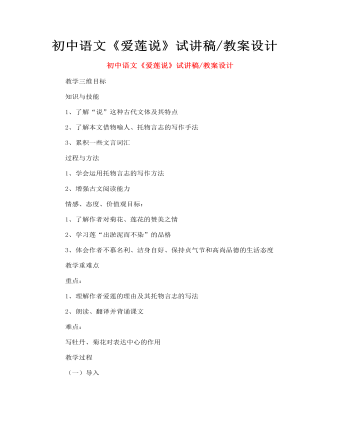
初中语文《爱莲说》试讲稿_教案设计
初读课文 了解文体,熟悉作者 文章的题目是《爱莲说》“爱”表现了作者的感情,“莲”是这篇文章写作的主体,“说” 在这里指什么? 明确:“说”是一种文体,可以说明事物,也可以发表议论或记叙事物 “说”这种文体可以灵活地运用说明、记叙和议论的表达方式,偏重于议论那么题目的意思是什么呢?可以理解为“谈谈爱莲花的道理”或“说说喜爱莲花的道理” 他爱莲花有什么道理呢?大家在学习课文中一定要开动小脑筋 本文作者周敦颐 ,(10171073) ,宋代道洲(现在湖南省道县)人,字茂叔,哲学家因他世居道县濂溪,后居庐山莲花峰前,峰下有溪,也命名为濂溪,学者就称他为“濂溪先生”

小学数学人教版五年级下册《质数和合数》说课稿
设计意图:我运用了引导学生探究发现的教学方法,学生采用观察比较、分类归纳、讨论交流的学习方法。因为“质数和合数”是学生在学习了因数和倍数的基础上进行学习的。因此我抓住新旧知识的连接点,让学生找自己座号的因数,从学生身边熟悉的事物入手,唤起学生亲切的情感,激发他们学习的兴趣。学生是学习的主体,只有让学生参与知识的形成过程,数学知识才会内化学生自己的东西,四人小组讨论交流就是让学生在探讨中提高学习的能力。5、科学总结 实战练习(1)基本练习。完成“做一做”。 (2)强化练习。练习四第1、2题。 (3)综合练习。1-80质数表。验证刚才的判断是否正确。师:通过这节课的学习,你又有了什么新的收获? 你能帮甜甜解决箱子密码的问题了吗?
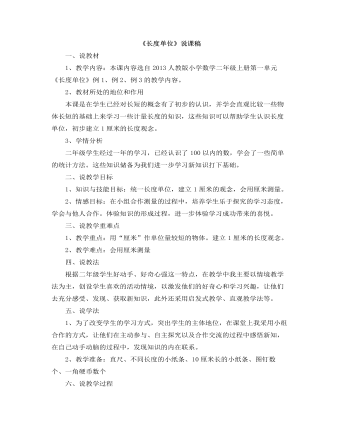
小学数学人教版二年级上册《长度单位》说课稿
一、说教材1、教学内容:本课内容选自2013人教版小学数学二年级上册第一单元《长度单位》例1、例2、例3的教学内容。 2、教材所处的地位和作用本课是在学生已经对长短的概念有了初步的认识,并学会直观比较一些物体长短的基础上来学习一些计量长度的知识,这些知识可以帮助学生认识长度单位,初步建立1厘米的长度观念。 3、学情分析二年级学生经过一年的学习,已经认识了100以内的数,学会了一些简单的统计方法。这些知识储备为我们进一步学习新知识打下基础。二、说教学目标1、知识与技能目标:统一长度单位,建立1厘米的观念,会用厘米测量。2、情感目标:在小组合作测量的过程中,培养学生乐于探究的学习态度,学会与他人合作。体验知识的形成过程,进一步体验学习成功带来的喜悦。
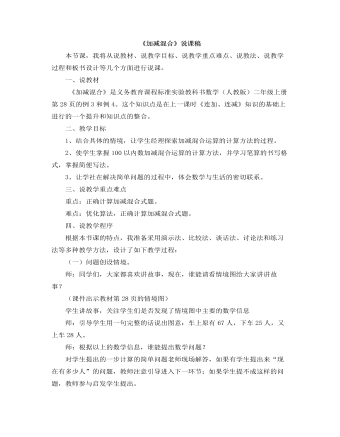
小学数学人教版二年级上册《加减混合》说课稿
一、说教材《加减混合》是义务教育课程标准实验教科书数学(人教版)二年级上册第28页的例3和例4。这个知识点是在上一课时《连加、连减》知识的基础上进行的一个提升和知识点的整合。二、教学目标 1、结合具体的情境,让学生经理探索加减混合运算的计算方法的过程。 2、使学生掌握100以内数加减混合运算的计算方法,并学习笔算的书写格式,掌握简便写法。 3、让学社在解决简单问题的过程中,体会数学与生活的密切联系。三、说教学重点难点重点:正确计算加减混合式题。 难点:优化算法,正确计算加减混合式题。 四、说教学程序 根据本节课的特点,我准备采用演示法、比较法、谈话法、讨论法和练习法等多种教学方法,设计了如下教学过程:

